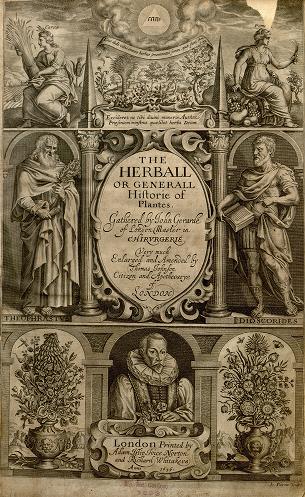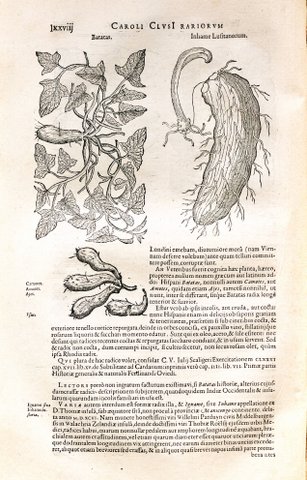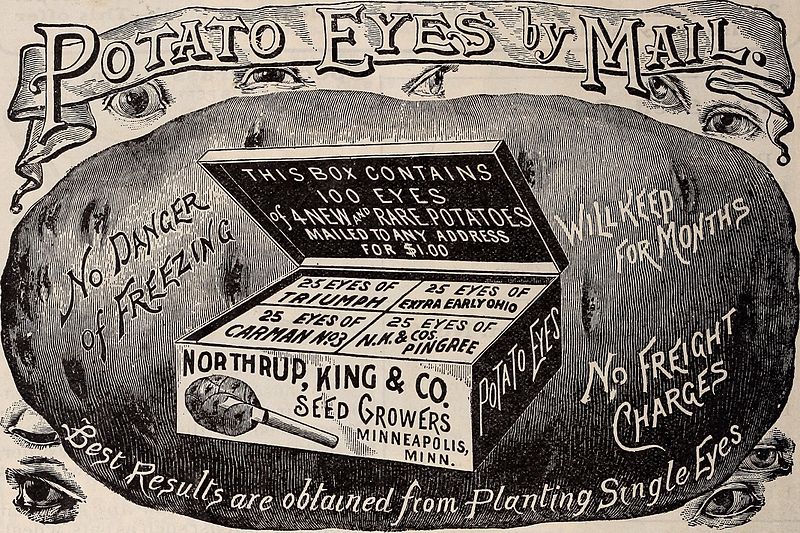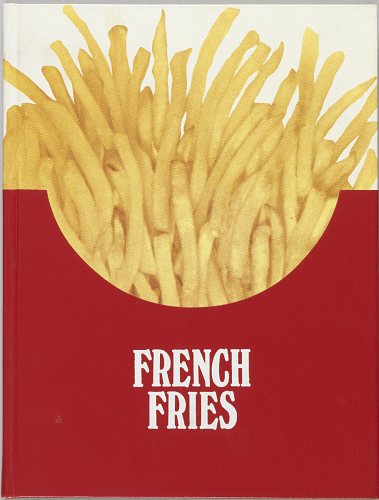September is National Potato Month. Almost all the potatoes grown in
the United States are planted in the spring and gathered in the fall. It
is the time of year that schools in northern Maine have “harvest break”
when students work to dig and sort the season’s spud crop soon after
summer vacation.
Maine’s custom is one small part of the very long
and interwoven agricultural, economic, social, culinary, medical, and
ritual histories of this humble staple. It is a story that stretches
from ancient gardens in the Andean Mountains 10,000 to 8,000 years ago …
to perhaps Mars in the future? In the recent movie,
The Martian,
the stranded astronaut-botanist (played by Matt Damon), bases his
long-term survival strategy on the Red Planet, not completely
unfeasibly, on planting potatoes. But is the potato relevant for us
today?
A carbohydrate, the tubers have nutritional detractors who
point out that Americans consume far too many calories from white
starches, including processed potato products in the forms of French
fries and chips (along with the harmful fats and salt that go with
them). With dehydrated and other potato products, these foods account
for fifty percent of the potato market. Meanwhile, the annual
consumption of fresh potatoes in the United States has fallen from
eighty-one pounds per person in 1960 to forty-two pounds recently (the
official Government report
here).
Potatoes are a hot political issue: Congress has fought successfully to
keep the white potato in food assistance programs, including those of
school lunches and breakfasts, against recommendations from the
Department of Agriculture.
Following rice, wheat, and corn,
potatoes are among the most consumed food crop in the world. The tuber
is easy to grow in a variety of climates and soils, and is not as
thirsty for water as many other vegetables, producing a high yield from a
small area. Able to be stored for long periods, the potato is a good
source of vitamin C (surprisingly), potassium, phosphorus, magnesium,
vitamin B₆, and some iron. Inexpensive, lacking only calcium and
vitamins A and D, it is almost a complete food. Beginning with the
ancient civilizations of Huari and Tiahuanacu located in parts of
modern-day Peru and Bolivia, the spud has been insurance against famine,
providing sustenance when other crops failed.
If there is a food stuff that deserves a commemorative month or day (May 30
th in Peru), it is the potato.
 |
| A selection of organic potatoes from both coasts: Idaho and Yukon Gold
from California; Honey Gold Nibbles, Gold Marbled Fingerlings, Purple
Peruvian, and Adirondack Red potatoes from the Mid-Atlantic area. There
are over a hundred varieties available. The petite type are growing in
popularity (quick to cook, creamy in texture) as a substitute for pasta
(photo by the author) |
Not surprisingly, the Smithsonian does not treat
the subject
as small potatoes. In most, if not all, of the twenty-one separate
libraries in the Institution, information on some aspect on the history
and culture of the potato can be found. So what better way to celebrate
the potato (
Solanum tuberosum) and find its relevancy than by
digging into some of Smithsonian Libraries’ holdings that tell its rich
story? From the Anthropology, American Indian, Natural History,
Horticulture and Botany libraries, the trade literature and cookery
collections of American History, and, of course, Special Collections,
all have original and secondary sources for an (almost) complete picture
of this highly significant plant.
Archaeological research finds
that the potato was first domesticated from wild plants on the shores of
Lake Titicaca in the Andes. With sophisticated agricultural technology,
including raised field terraces and irrigation systems, Pre-Inca
cultures came to thrive on huge yields of the crop. The Inca Empire
relied on potato storehouses, including a freeze-dried product (
chuña)
that could hold for years, in times of crop failures. Pedro de Cieza de
León, explorer and historian, described the cultivation and cooking in
his
Chronicles of Peru,
in 1540. Spanish conquistadors, who largely destroyed the Inca
civilization, brought the potato across the Atlantic. Early accounts are
a bit murky with the confusion between white (
papas) and sweet potatoes (
batata), but they were cultivated on the Canary Islands from 1565 and then onto the mainland of Spain.
 |
- John Gerard, The Herball, or, Generall historie of plantes
(Imprinted at London by John Norton, 1597). There had been an earlier
written description (but with no illustration) of the plant in Gaspard
Bauhin’s Phytopinax of 1596. The Dibner Library of the
Smithsonian Libraries has this first edition of Gerard. The Biodiversity Heritage
Library has digitized the copy in the Peter H. Raven Library, Missouri
Botanical Garden (pictured here).
|
Potatoes were being grown in London not long afterwards. The first
printed pictures of the potato plant appear in woodcut illustrations in
John Gerard’s great
Herball
of 1597. Gerard, who grew the plants in his own garden, misidentifies
the origin of the potato as Virginia. It was not introduced into North
America until the 1620s when the British governor of the Bahamas sent
the tuber, along with other vegetables, to the Jamestown colony
in Virginia. However, Derry, New Hampshire claims the first potato patch
in North America,
planted in 1719 when Scot-Irish immigrants settled in the area.
 |
| The 1636 edition of Gerard's Herball. The author holds a spray
of potato flowers in the illustrated title page of the book, seen in the
bottom center, just above the imprint. The Cullman Library of the
Smithsonian has two copies; this image is from the scanned copy in the Peter H. Raven Library of the Missouri Botanical Garden (from the catalog of the Biodiversity Heritage Library). |
From England, the potato moved to France and then on to the Netherlands.
Carolus Clusius (or Charles de l’Ecluse) introduced the potato to the
Low Countries. Woodcut illustrations are in his
Rariorum plantarum historia (
The history of rare plants;
Antwerp, 1601). Because potatoes were a good source for preventing
scurvy on long voyages, they were distributed via shipboard provisions
to the far reaches of the world in the age of exploration. Potatoes also
lessened the effects of tuberculosis, measles and dysentery. But the
tuber became stigmatized as it moved from the exclusive botanical
gardens of the wealthy in the 17
th century, when it was thought to be poisonous and fit only for livestock or the truly indigent.
 |
| Clusius' Rariorum plantarum historia (Antwerp, 1601). Images of
the white and the sweet potatoes (above and below) from the scanned
copy in the Peter H. Raven Library of the Missouri Botanical Garden by
the Biodiversity Heritage Library (link). The Smithsonian's Cullman Library also has the title. |
 |
| Clusius also created the first European representation of the potato, a
lovely watercolor of 1588 of a plant in his garden. The work of art,
with a note written by Clusius, is now in the Plantin-Moretus Museum in
Antwerp (link here). |
In Europe and Russia during the second half of the 18
th
century the potato was vigorously promoted to lessen the economic
distress of successive disastrous harvests of corn and wheat. Various
groups and individuals produced pamphlets and books to educate and extol
the crop’s virtues, such as the
Society for the Encouragement of Arts, Manufactures and Commerce, and military pharmacist and agronomist
Antoine Augustin Parmentier. An example is
Memoria sopra I pomi di terra (
Memoire on the potatoes) of 1767, an Italian translation of a French publication (Dibner Library) that discusses varieties and cooking methods.
In
France, the tuber was particularly regarded as a poor person’s food.
Sadly, the Smithsonian Libraries does not own a copy of the important
Parmentier work,
Examen chimique de la pomme de terre (
Chemical examination of the potato,
1778). He was so successful in his efforts that some still believe he
invented the potato, and there are many dishes named for him, such as
the casserole of veal chops à la Parmentier.
By the 19
th
century, the potato was common and so prevalent that historians debate
its exact role in fueling the population explosion of the period. The
food stuff also was being put to other uses, such as in alcoholic
spirits. John Ham’s
The theory and practice of brewing, from malted corn and from potatos
(London, 1829), is one such treatise. There are many gardening manuals
in the Smithsonian Libraries that discuss all the types then being
developed and best methods of growing and storage. William Cobbett’s
The American gardener (London, 1821) has this charming entry:
"Potatoe – Every body knows how to cultivate this plant; and, as to its preservation during winter, if you can ascertain the degree of warmth necessary to keep a baby
from perishing, you know precisely the precautions required to preserve
a potatoe. – As to sorts they are as numerous as the stones of a
pavement in a large city."
But such dependency on a single crop, relied on by a huge population,
proved ripe for disaster. This came in the form of late blight disease
in the 1840s, which struck hard in Europe and was particularly
devastating in
Ireland. These catastrophes led to the development of disease-resistant plants, in particular by American horticulturist
Luther Burbank
who worked to improve the Irish potato; he bred a type in 1872 that
established the Idaho potato. These new varieties led to even more
potato dominance in food production and plantings around the world. It
is a story likely to play out again with climate change, as scientists
work to develop cultivars even more resistant to heat, drought and
disease. To lessen pollution and water use and help feed its exploding
population, China is now by far the largest producer of the staple in
the world. Will the potato once again save some parts the world?
(see Zuckerman, Larry.
The potato: how the humble spud rescued the western world. Boston, 1998 and this Wikipedia
entry on the subject).
 |
| "Good seeds at fair prices": National Museum of American History Trade Catalogs of 1902 from Minneapolis, Minnesota (image from Wikimedia Commons of the copy in the National Agricultural Library) |
The extensive agricultural
trade literature collections in the Smithsonian illustrate the trends in the potato’s popularity and dominance into the 20
th century (one example linked
here). The evolution of the vegetable as source of sustenance to a snack food is also traced in the Libraries’ culinary
holdings. Thomas Jefferson had "potatoes served in the French manner" at a White House dinner in 1802 (not, strictly speaking, and
contrary to the myth,
the French fry). A relative of Jefferson’s, Mary Randolph, had seven
recipes for potatoes, including one “to fry sliced potatoes” in her
book,
The Virginia house-wife, or, Methodical cook.
The Dibner Library holds the fourth edition of this important cookbook,
published in 1830. The Russet Burbank potato, developed in the 1920s,
long, regular with a high sugar content, is the hybrid ideal for French
fries. Speaking of which, France and Belgium are still arguing over who
invented “French fries.”
 |
| An artist book in the collections: French fries : a new play, written by Dennis Bernstein, Warren Lehrer ; designed by Warren Lehrer, 1984. |
This short history, centered on the Smithsonian Libraries collections,
merely skims the surface of the potato. So even if you tend to avoid
white potatoes in your diet, pick up one of the many, many accounts of
the spud to read or raise a fork to the potato this month and celebrate
this small vegetable’s big history in the world. In the words of
Winnie-the-Pooh creator A. A. Milne: “What I say is that, if a fellow
really likes potatoes, he must be a pretty decent sort of fellow”
(“Lunch” in
Not that it matters, 1919).
Julia Blakely
Special Collections Cataloger
Smithsonian Libraries
For further reading:
Chilies to chocolate: food the Americas gave the world. Tucson, 1992.
Hawkes, J. G.
The potatoes of Argentina, Brazil, Paraguay, and Uruguay: a biosystematics study. Oxford, 1969.
Ochoa, Carlos M.
Las papas de Sudamérica. Lima, Perú, 1999.
Salaman, Redcliffe N.
The history and social influence of the potato. Cambridge, 1985.
 |
| Well, if you are going to have bacon with your potatoes, might as well
have sour cream as well. Photo by the author but the great recipe and story from the New York Times. |



































